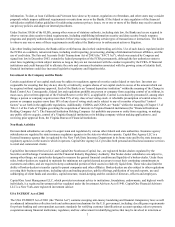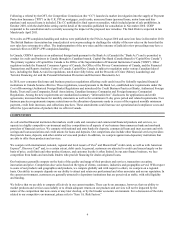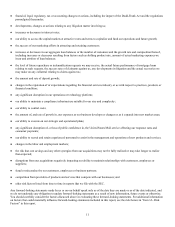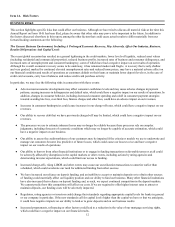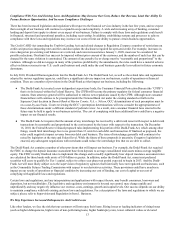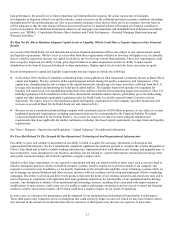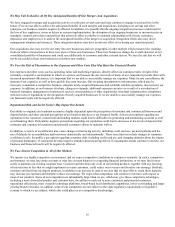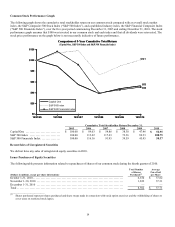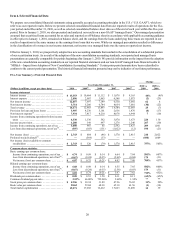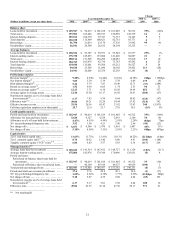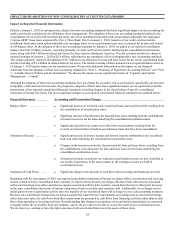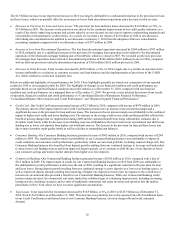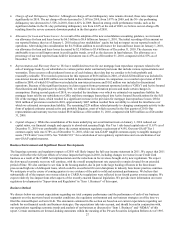Capital One 2010 Annual Report Download - page 37
Download and view the complete annual report
Please find page 37 of the 2010 Capital One annual report below. You can navigate through the pages in the report by either clicking on the pages listed below, or by using the keyword search tool below to find specific information within the annual report.17
Fluctuations in Market Interest Rates Or the Capital Markets Could Adversely Affect Our Revenue and Expense, the Value of
Assets and Obligations, Our Cost of Capital or Our Liquidity
Like other financial institutions, our business may be sensitive to market interest rate movement and the performance of the financial
markets. Changes in interest rates or in valuations in the debt or equity markets could directly impact us. For example, we borrow
money from other institutions and depositors, which we use to make loans to customers and invest in debt securities and other earning
assets. We earn interest on these loans and assets and pay interest on the money we borrow from institutions and depositors.
Fluctuations in interest rates, including changes in the relationship between short-term rates and long-term rates and in the relationship
between our funding basis rate and our lending basis rate, may have negative impacts on our net interest income and therefore our
earnings. In addition, interest rate fluctuations and competitor responses to those changes may effect the rate of customer pre-
payments for mortgage, auto and other term loans and may affect the balances customers carry on their credit cards. These changes
can reduce the overall yield on our earning asset portfolio. Changes in interest rates and competitor responses to these changes may
also impact customer decisions to maintain balances in the deposit accounts they have with us. In addition, changes in valuations in
the debt and equity markets could have a negative impact on the assets we hold in our investment portfolio. Finally, such market
changes could also have a negative impact on the valuation of assets for which we provide servicing.
We assess our interest rate risk by estimating the effect on our earnings under various scenarios that differ based on assumptions about
the direction and the magnitude of interest rate changes. We take risk mitigation actions based on those assessments. We face the risk
that changes in interest rates could reduce our net interest income and our earnings in material amounts, especially if actual conditions
turn out to be materially different than those we assumed. See “MD&A—Market Risk Management” for additional information.
Our Business Could Be Negatively Affected If It Is Unable to Attract, Retain and Motivate Skilled Senior Leaders
Our success depends, in large part, on our ability to retain key senior leaders, and competition for such senior leaders can be intense in
most areas of our business. The executive compensation provisions of the Dodd-Frank Act and the regulations issued thereunder, and
any further legislation or regulation restricting executive compensation, may limit the types of compensation arrangements that we
may enter into with our most senior leaders and could have a negative impact on our ability to attract, retain and motivate such leaders
in support of our long-term strategy. These laws and regulations may not apply in the same manner to all financial institutions, and we
therefore may face more restrictions than other institutions and companies with whom we compete for talent. If we are unable to retain
talented senior leadership, our business could be negatively affected.
Our Businesses are Subject to the Risk of Increased Litigation
Our businesses are subject to increased litigation as a result of the highly regulated nature of the financial services industry and the
structure of the credit card industry, and we face risks from the outcomes of such industry litigation. Substantial legal liability against
us could have a material adverse effect or cause significant reputational harm to us, which could seriously harm our business. For a
description of the litigation risks that we face, see “Note 21—Commitments, Contingencies and Guarantees.”
We Face Risks from Unpredictable Catastrophic Events
Despite our substantial business contingency plans, the impact from natural disasters and other catastrophic events, including terrorist
attacks, may have a negative effect on our business and infrastructure, including our information technology systems. The impact of
such events and other catastrophes on the overall economy may also adversely affect our financial condition and results of operations.
We Face Risks from the Use of Estimates in Our Financial Statements
Pursuant to United States Generally Accepted Accounting Principles, we are required to use certain assumptions and estimates in
preparing our financial statements, including, but not limited to, estimating our allowance for loan and lease losses and the fair value
of certain assets and liabilities. If the assumptions or estimates underlying our financial statements are incorrect, we may experience
unexpected material losses. For a discussion of our use of estimates in the preparation of our consolidated financial statements, see
“Note 1—Summary of Significant Accounting Policies.”
Item 1B. Unresolved Staff Comments
None.
Item 2. Properties
Our corporate real estate portfolio is used to support our business segments. We own our 587,000 square foot headquarters building in
McLean, Virginia which houses our executive offices and northern Virginia staff. We own approximately 316 acres of land in


